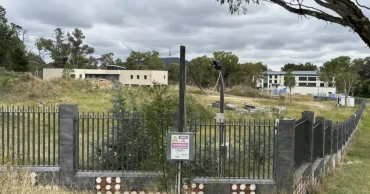australia
Tensions rise in Australia after a bishop and priest are wounded in a knife attack in a church
A teenager has been accused of wounding a Christian bishop and priest during a church service in a second high-profile knife attack to rock Sydney in recent days, leaving communities on edge, leaders calling for calm and a besieged church urging against retaliation.
The 16-year-old was overpowered by the shocked congregation at Christ the Good Shepherd Church after he allegedly stabbed Bishop Mar Mari Emmanuel and Fr. Isaac Royel during a service on Monday night that was being streamed online.
Police have not commented on reports that the boy’s fingers were severed by parishioners in the Orthodox Assyrian church in suburban Wakeley, but confirmed his hand injuries were “severe.”
Video of the attack spread quickly on social media and an angry mob converged on the church demanding vengeance. They hurled bricks, bottles and fence boards at police, who temporarily barricaded the boy inside the church for his own safety. Many in the crowd chanted “an eye for an eye” and “bring him out.”
Several people including police officers required hospital treatment following the hourslong riot.
The church said in a statement on Tuesday it "denounced retaliation of any kind.” Police stood guard around mosques in parts of Sydney on Tuesday after reports that text messages were circulating urging the Assyrian Christian community to retaliate against Muslims.
Police and community leaders said public anxiety had been heightened by a lone assailant’s knife attack in a Sydney shopping mall on Saturday that killed five women and a male security guard who attempted to intervene. The 40-year-old assailant, Joel Cauchi, had a history of mental illness and trouble with women and a fascination with knives. He was shot dead by police.
Prime Minister Anthony Albanese urged the public not to take the law into their own hands.
“We understand the distress and concerns that are there in the community, particularly after the tragic event at Bondi Junction on Saturday,” Albanese told reporters, referring to the Westfield Bondi Junction shopping mall.
"But it is not acceptable to impede police and injure police doing their duty or to damage police vehicles in a way that we saw last night," Albanese added.
News South Wales Police Commissioner Karen Webb on Tuesday declared the church attack a terrorist incident, but not the shopping mall rampage.
The terrorism categorization allows more law enforcement resources to be focused on the crime. The declaration also gives police expanded powers to stop and search people, premises and vehicles without a warrant.
Webb said the teen's comments and actions pointed to a religious motive for the attack. She didn’t detail the wording of the comments that led her to believe he had been religiously motivated.
Ten Network television reported the boy had told churchgoers who restrained him in Arabic: “If they didn't insult my Prophet, I wouldn't have come here.”
The Australian Security Intelligence Organization, the nation’s main domestic spy agency, and Australian Federal Police have joined state police in a counterterrorism task force to investigate who else was potentially involved.
ASIO Director-General Mike Burgess agreed with Webb that the mall attack was not terrorism as defined by Australian authorities.
To call it a terrorist attack, there must be “information or evidence that suggests actually the motivation was religiously motivated or ideologically motivated,” Burgess said. “In the case of Saturday, that was not the case. In this case, the information we and the police have before us ... would indicate strongly that that is the case and that’s why it was called an act of terrorism."
A coronial inquest will investigate the circumstances of the six knife deaths in the mall attack and what policy changes could be made to prevent similar attacks from occurring in the future. The coroner will also consider whether security guards should be armed. Westfield Bondi Junction mall guards, including knife victim Faraz Tahir, do not carry guns.
New South Wales Premier Chris Minns said he was reviewing government restrictions on how security guards could be armed following the knife attack. But he has ruled out allowing them to carry guns, saying the fewer firearms in the community, the better.
Mass killings are relatively rare in Australia because assault rifle-style semi-automatic firearms are banned from public ownership under tough national gun laws.
Webb said the teen suspect in the church attack had been known to police, but was not on a terror watch list. He had been convicted in January for a range of offenses including possession of a switchblade knife, being armed with a weapon with an intention to commit an indictable offense, stalking, intimidation and damaging property, Australian Broadcasting Corp. reported.
A Sydney court released him on a good behavior bond, ABC reported.
The boy used a switchblade, which is an illegal weapon in Australia, in Monday’s attack, ABC reported.
Juvenile offenders cannot be publicly identified in New South Wales.
The church in a message on social media said the bishop and priest were in stable condition and asked for people’s prayers. The church said in a statement on Tuesday the 53-year-old Iraq-born bishop’s condition was “improving.”
Emmanuel has a strong social media following and is outspoken on a range of issues. He proselytizes to both Jews and Muslims and is critical of liberal Christian denominations. He also speaks out on global political issues and laments the plight of Palestinians in Gaza.
The bishop, described in local media as a sometimes divisive figure on issues such as COVID-19 restrictions, was in the national news last year over comments about gender.
He was ordained a bishop in the Ancient Church of the East in 2011 but established an independent church four years later in the Eastern Syriac tradition.
Assyrians are a predominantly Christian ethnic group native to ancient Mesopotamia, which is now carved up between Iraq, Iran, Syria and Turkey.
Australian police probe why man who stabbed 6 people to death in a Sydney mall targeted women
Australian police are examining why a lone assailant who stabbed six people to death in a busy Sydney shopping mall and injured more than a dozen others targeted women while avoiding men, a police commissioner said on Monday.
Police shot and killed the homeless assailant, Joel Cauchi, during his knife attack in the Westfield Bondi Junction mall on Saturday near world-famous Bondi Beach.
Police have ruled out terrorism and said the 40-year-old had a history of mental illness.
New South Wales state Police Commissioner Karen Webb said detectives would question Cauchi’s family in a bid to determine his motive. CCTV footage from the mall showed Cauchi targeted women.
“The videos speak for themselves, don’t they? And that’s certainly a line of inquiry for us,” Webb told Australian Broadcasting Corp.
At least 53 men massacred in Papua New Guinea tribal violence, police tell Australian media
“It’s obvious to me, it’s obvious to detectives that that seems to be an area of interest: that the offender had focused on women and avoided the men,” Webb added.
The only male killed was Faraz Tahir, a Pakistani refugee who worked at the mall as a security guard. Tahir had not been armed.
Most of the 12 victims who survived their wounds were also women, Webb said.
The evidence will be provided to a coroner to report on the circumstances of the deaths.
Webb expected the coroner would also address the question of whether security guards at the mall, which is one of Australia’s largest, should be armed.
The families of two victims based overseas had been advised of their deaths, police said. Those victims are Tahir, 30, from Pakistan, and Yixuan Cheng, 27, from China. Also killed were Jade Young, 47; Dawn Singleton, 25; Pikria Darchia, 55; and Ashlee Good, 38.
Eight victims who survived their injuries remained in hospitals on Monday, including Good’s 9-month-old daughter. The baby’s condition improved overnight Sunday from critical to serious, health authorities said.
The conditions of the other seven ranged from critical to stable.
Flags on government buildings around Australia flew at half-staff on Monday as a day of national mourning was declared to honor the victims. A black ribbon will appear on the sails of the Sydney Opera House on Monday night has part of a light display.
Australia becomes first country to legalise medical psychedelics
Police had given control of the seven-story crime scene back to the mall operators on Sunday night, but a decision has yet to be announced on when it will reopen for business.
The police officer who has been credited with saving many lives by shooting Cauchi dead, Insp. Amy Scott, will be interviewed by detectives on Tuesday.
Man stabs 6 people to death at busy Sydney shopping centre before being shot by police
A man stabbed six people to death at a busy Sydney shopping center Saturday before he was fatally shot, police said. Multiple people, including a small child, were also injured in the attack.
The suspect stabbed nine people at the Westfield Shopping Centre in Bondi Junction, which is in the city’s eastern suburbs, before a police inspector shot him after he turned and raised a knife, New South Wales Assistant Police Commissioner Anthony Cooke told reporters. Six of the victims and the suspect died. Police had no specific details on the condition of the injured.
Cooke said he believed that the suspect acted alone, and he was “content that there is no continuing threat.” He said officials didn’t know who the offender was. “This is quite raw,” he said, and a ”lengthy and precise" investigation was just beginning.
At least 53 men massacred in Papua New Guinea tribal violence, police tell Australian media
He said there was “nothing that we are aware of at the scene that would indicate any motive or any ideology.” When asked whether officials were ruling out terrorism, he said: “We’re not ruling anything out.”
Cooke said the police inspector, a senior officer, was alone when she confronted the suspect and engaged him soon after her arrival on the scene, “saving a range of people's lives.”
Video showed many ambulances and police cars around the shopping center, and people streaming out.
Paramedics were treating patients at the scene.
Australian prime minister announces China visit hours before leaving for US to meet Biden
Witness Roi Huberman, a sound engineer at ABC TV in Australia, told the network that he sheltered in a store during the incident.
“And suddenly we heard a shot or maybe two shots and we didn’t know what to do,” he said. “Then the very capable person in the store took us to the back where it can be locked. She then locked the store and then she then let us through the back and now we are out.”
At least 53 men massacred in Papua New Guinea tribal violence, police tell Australian media
At least 53 men were massacred in a major escalation of tribal violence in Papua New Guinea, Australian media reported Monday.
A tribe, their allies and mercenaries were on their way to attack a neighboring tribe when they were ambushed Sunday in Enga province in the South Pacific nation's remote highlands, Royal Papua New Guinea Constabulary Acting Superintendent George Kakas told Australian Broadcasting Corp.
Police expected to find more dead bodies among the wounded who had escaped into the woods, he said. “These tribesmen have been killed all over the countryside, all over the bush,” Kakas told ABC.
Bodies were collected from the battlefield, roads and the riverside, then loaded onto police trucks and taken to the hospital. Kakas said authorities were still counting “those who were shot, injured and ran off into the bushes.”
“We presume the numbers will go up to 60 or 65,” he said.
Kakas said it could be the highest death toll from such violence in the highlands, where there are few roads and most of the inhabitants are subsistence farmers.
Read: Relatives of massacred Americans say Mexico needs help
Police in the capital of Port Moresby did not immediately respond to the AP’s request for information on the massacre.
Papua New Guinea is a diverse, developing nation of 10 million people with 800 languages in a strategically important part of the South Pacific.
Internal security has become an increasing challenge for its government as China, the United States and Australia seek closer security ties.
Australian Prime Minister Anthony Albanese said his government was ready to assist Papua New Guinea, which is Australia's nearest neighbor and the largest single recipient of Australian foreign aid.
“That is very disturbing the news that has come out of Papua New Guinea,” Albanese said.
“We remain available to provide whatever support we can in a practical way, of course, to help our friends in PNG,” Albanese added.
Read: South China Sea tensions and Myanmar violence top agenda for Southeast Asian envoys meeting in Laos
Albanese said Australia was already providing “considerable support” for Papua New Guinea and was helping train the country’s police officers.
Tribal violence in the Enga region has intensified since elections in 2022 that maintained Prime Minister James Marape's administration. Elections and accompanying allegations of cheating and process anomalies have always triggered violence throughout the country.
Enga Gov. Peter Ipatas said there were warnings that tribal fighting was about to erupt.
“From a provincial perspective, we knew this fight was going to be on and we (alerted) the security forces last week to make sure they took appropriate action to ensure this didn’t occur,” Ipatas told ABC.
Read more: Climate Change and violence against women should be dealt with conviction, says International Inner Wheel President Trish Douglas
Ipatas described the violence as a "very, very sad occasion for us in the province and it’s a bad thing for the country.”
Australian prime minister announces China visit hours before leaving for US to meet Biden
Australian Prime Minister Anthony Albanese will visit China in early November, his office said Sunday hours before he was set to fly to the United States to meet President Joe Biden.
Albanese's office also said China agreed to review the crippling tariffs it placed on Australian wine that have effectively blocked trade with the winemakers’ biggest export market since 2020.
Albanese will become the first Australian prime minister to visit China in seven years when he travels to Beijing and Shanghai from Nov. 4-7.
He will meet President Xi Jinping and Premier Li Qiang in Beijing and then attend the China International Import Expo in Shanghai.
The visit to China and a potential breakthrough in the wine dispute mark a further repair in bilateral relations since Albanese’s center-left Labor Party won elections last year after nine years of conservative rule in Australia.
Read: Australian-Chinese journalist detained for 3 years in China returns to Australia
“I look forward to visiting China, an important step towards ensuring a stable and productive relationship,” Albanese said in a statement.
“I welcome the progress we have made to return Australian products, including Australian wine, to the Chinese market. Strong trade benefits both countries,” Albanese added.
Albanese accepted an invitation weeks ago to visit China this year, but finding suitable dates has been challenging.
Albanese is visiting Washington, D.C., to meet Biden this week and will return to the United States after his China trip to attend the Asia-Pacific Economic Cooperation leaders’ forum in San Francisco from Nov. 15-17.
Read: China lifts ban on Australian timber imports in another sign of improving bilateral relations
It will be the ninth time Biden has met Albanese as prime minister. The first meeting was in Tokyo hours after Albanese was sworn in as government leader in May last year.
The discussions this week are expected to cover the AUKUS deal in which the United States and Britain will cooperate to provide Australia with a fleet of submarines powered by U.S. nuclear technology to counter a more assertive China.
The leaders will also seek more cooperation on clean energy, critical minerals and countering climate change.
Read more: Australian lawmaker breaks ranks to support Indigenous Voice
King Charles III's image to appear on Australian coins this year
An image of King Charles III will soon appear on Australian coins, more than a year after the death of his mother Queen Elizabeth II, officials said Thursday.
The gold Australian dollar coin will be the first with an image of the new British monarch, who is also Australia’s head of state, Royal Australian Mint chief executive Leigh Gordon said.
About 10 million of the dollar coins will be circulating by Christmas, he said.
Assistant Minister for Treasury Andrew Leigh said the government had not wanted to rush the coin transition following the queen’s death in September last year.
Read: Crowds, dignitaries gather for King Charles III's coronation
“Certainly, we’re keen to get as many of the new coins with the king’s face on them out there as quickly as possible,” Leigh said.
The remaining denominations -– 5, 10, 20 and 50 cent coins plus a $2 coin -– will be rolled out with the king’s left profile and without a crown during 2024 based on demand from banks.
The latest queen’s image wore a crown. In maintaining tradition, the right profile of the queen was shown.
The king’s image is the official Commonwealth Effigy designed by The Royal Mint in London with the king’s approval and is available for use by all British Commonwealth countries.
The 15.5 billion Australian coins carrying the queen’s image minted since Australia introduced decimal currency in 1966 will remain legal tender. She has appeared on Australian money since 1953.
Read: Rishi Sunak becomes UK's 3rd PM this year by King Charles III
The government was criticized over a decision this year to replace the queen’s image on the $5 note with an Indigenous design rather than an image of the king.
The $5 bill had been Australia’s only remaining bank note to still feature an image of the monarch.
Critics saw it as part of a plan by the center-left Labor Party government to replace the British monarch as Australia’s head of state with an Australian president.
Leigh said there was no plan to remove the monarch from Australian coins.
Read more: First coins featuring King Charles III unveiled
Live worm found in woman's brain in Australia
Australian doctors have found a live parasitic worm in a woman's brain in a world-first discovery.
In a new study published on Tuesday, researchers from the Australian National University (ANU) and Canberra Hospital detailed the discovery of the parasitic roundworm.
The eight-cm Ophidascaris robertsi roundworm, which is usually found in pythons, was pulled from the patient, a 64-year-old woman, still alive and wriggling after brain surgery.
Read: Son stolen at birth hugs Chilean mother for first time in 42 years
Sanjaya Senanayake, a leading infectious disease expert from ANU and the Canberra Hospital, said in a media release that it was a world-first.
According to the study, the patient was admitted to a local hospital in south-east New South Wales (NSW) in 2021 after three weeks of abdominal pain and diarrhea.
In 2022, after she started experiencing forgetfulness and depression, a neurosurgeon at Canberra Hospital identified an abnormality in the right frontal lobe of the brain from an MRI scan, prompting the surgery that discovered the roundworm.
Read: Cyprus rescues 115 Syrian migrants aboard 3 separate boats over the last three days
The study hypothesizes that the patient was probably infected by touching, or eating, native grasses that a carpet python had shed the parasite into.
She remains under monitoring by infectious disease and brain experts.
Australia becomes first country to legalise medical psychedelics
Australia is now the first country to allow psychiatrists to prescribe certain psychedelic substances to patients with depression or post-traumatic stress disorder.
Beginning Saturday, Australian physicians can prescribe doses of MDMA, also known as ecstasy, for PTSD. Psilocybin, the psychoactive ingredient in psychedelic mushrooms, can be given to people who have hard-to-treat depression. The country put the two drugs on the list of approved medicines by the Therapeutic Goods Administration.
Scientists in Australia were surprised by the move, which was announced in February but took effect July 1. One scientist said it puts Australia "at the forefront of research in this field."
Chris Langmead, deputy director of the Neuromedicines Discovery Centre at the Monash Institute of Pharmaceutical Sciences, said there have been very few advancements on treatment of persistent mental health issues in the last 50 years.
After years of waiting, medical marijuana sold in Louisiana
The growing cultural acceptance has led two U.S. states to approve measures for their use: Oregon was the first to legalize the adult use of psilocybin, and Colorado's voters decriminalized psilocybin in 2022. Days ago, President Joe Biden's youngest brother said in a radio interview that the president has been "very open-minded" in conversations the two have had about the benefits of psychedelics as a form of medical treatment.
The U.S. Food and Drug Administration designated psilocybin as a "breakthrough therapy" in 2018, a label that's designed to speed the development and review of drugs to treat a serious condition. Psychedelics researchers have benefited from federal grants, including Johns Hopkins, and the FDA released draft guidance late last month for researchers designing clinical trials testing psychedelic drugs as potential treatments for a variety of medical conditions.
New Zealand law to make medical marijuana widely available
Still, the American Psychiatric Association has not endorsed the use of psychedelics in treatment, noting the FDA has yet to offer a final determination.
And medical experts in the U.S. and elsewhere, Australia included, have cautioned that more research is needed on the drugs' efficacy and the extent of the risks of psychedelics, which can cause hallucinations.
US growing largest crop of marijuana for research in 5 years
"There are concerns that evidence remains inadequate and moving to clinical service is premature; that incompetent or poorly equipped clinicians could flood the space; that treatment will be unaffordable for most; that formal oversight of training, treatment, and patient outcomes will be minimal or ill-informed," said Dr. Paul Liknaitzky, head of Monash University's Clinical Psychedelic Lab.
Canada now world's largest legal marijuana marketplace
Plus, the drugs will be expensive in Australia — about $10,000 (roughly $6,600 U.S. dollars) per patient for treatment.
Uruguay is betting on exports of medical marijuana
Litnaitzky said the opportunity for Australians to access the drugs for specific conditions is unique.
"There's excitement about drug policy progress," he said, "... about the prospect of being able to offer patients more suitable and tailored treatment without the constraints imposed by clinical trials and rigid protocols."
Thailand approves medical marijuana
Australia’s High Court dismisses Russia’s bid for injunction to stop its embassy’s eviction
Australia’s highest court on Monday dismissed Russia’s application for an injunction that would have prevented Moscow's embassy being evicted from a site in the national capital Canberra.
In dismissing the application, High Court Justice Jayne Jagot described Russia’s challenge on constitutional grounds to a law terminating the lease as “weak” and “difficult to understand.”
Parliament passed emergency legislation on June 15 that terminated Russia’s lease on the largely empty block on security grounds because the new embassy would have been too close to Parliament House.
Read: With Russia revolt over, mercenaries' future and direction of Ukraine war remain uncertain
Russia’s lawyer Elliot Hyde had argued that the Ambassador Alexey Pavlovsky would not have confidence in the integrity and security of a consular building already on the site if the embassy was not allowed to maintain possession until the challenge to the validity of the lease termination was decided.
Elliot said a man who has been living on the site in a portable cabin at least since last week was a security guard protecting the compound. The man had been described in the media as a Russian diplomat.
Read: When wealthy adventurers take huge risks, who should foot the bill for rescue attempts?
Prime Minister Anthony Albanese said he welcomed the High Court decision and expected the Russians to leave the site.
"The court has made clear that there is no legal basis for a Russian presence to continue on the site at this time, and we expect the Russian Federation to act in accordance with the court’s ruling," Albanese told reporters.
Read: Taliban leader claims women are provided with a 'comfortable and prosperous life' in Afghanistan
The Russian Embassy did not immediately respond to a request for comment. Previously, Russia had accused Australia of “Russophobic hysteria” for canceling the lease of the site in Canberra's diplomatic quarter where Moscow wanted to build a new embassy. The current Russian Embassy is in the Canberra suburb of Griffith and its operations are unaffected.
Twitter given 28 days to clean up "toxicity and hate" in Australia
Australia’s online safety watchdog has issued a legal notice to Twitter demanding an explanation of what the social media giant is doing to tackle a surge in online hate since Tesla CEO Elon Musk bought the platform.
Australia’s eSafety Commission describes itself as the world’s first government agency dedicated to keeping people safer online. The agency said Thursday that it received more complaints about online hate on Twitter in the past 12 months than any other platform and had received an increasing number of reports of serious online abuse since Musk took over the company in October.
The Australian agency’s boss, eSafety Commissioner Julie Inman Grant, said she sent a notice to the San Francisco-based company Wednesday with 36 detailed questions on how Twitter's policies about hateful conduct are enforced.
If Twitter does not respond with factual and truthful responses to all questions within 28 days, an Australian judge could fine the company up to 700,000 Australian dollars ($476,000) for every day of delay, Inman Grant said.
“The whole idea of the basic online safety expectations is that global companies like Twitter are enforcing their own policies … and that they’ve got people and technology to keep their platforms safe,” Inman Grant said.
“They have a Hateful Conduct policy that says you may not directly attack other people on the basis of race, ethnicity, gender, etc., and I want to know if fundamentally they are enforcing this policy and how effectively they are doing so,” she added.
Twitter did not immediately respond to a request for comment Thursday.
The eSafety notice followed Musk's announcement in November that he was granting “amnesty” for suspended accounts. This led to 62,000 banned or suspended users being reinstated to the platform, including 75 accounts with more than 1 million followers each, eSafety said in a statement.
Twitter’s global workforce had been slashed under Musk from 8,000 employees to 1,500, with trust and safety teams shed. Twitter had removed all public policy staff from Australia.
Inman Grant said Indigenous Australians, disabled people and those who identify as LGBTQ+ experience online hate at double the rate of other Australians.
“A third of all reports into our office of online hate are coming from Twitter. It’s been a huge surge since October '22 when Elon Musk took over," Inman Grant told Australian Broadcasting Corp. "Twitter has always been fiery in terms of discourse, but it’s turned into an absolute bin fire.”
“A lot of the changes to the algorithms have made people feel like you see more toxicity, much more coarse discourse. But without lifting the hood and using these transparency powers, we really don’t know what’s happening and this is where we’re trying to get to the bottom of things,” she added.
Australians are not alone in their increasingly hostile experience with Twitter. American advocacy group GLAAD said last week that all major social media platforms do poorly at protecting LGBTQ+ users from hate speech and harassment. But Twitter was the worst.
In its annual Social Media Safety Index, GLAAD gave Facebook, Instagram, TikTok, YouTube and Twitter low or failing scores, saying the platforms don’t do enough to keep their users safe. That said, most improved from a year ago.
Twitter was the only exception. GLAAD’s scorecard called it “the most dangerous platform for LGBTQ people” and the only one that saw its scores decline from last year — to 33% from 45% a year ago.
British rights group Center for Countering Digital Hate found instances of racial slurs on Twitter soared immediately after Musk bought the company.
A racial epithet used to attack Black people was found more than 26,000 times in the week following Musk’s takeover — three times the average for 2022, the center found.
The center also found users who pay for a Twitter Blue Check seemed to enjoy a level of impunity from the platform’s rules on online hate.
Inman Grant chairs the Global Online Safety Regulators Network, which was formed with British, Irish and Fijian online harms regulators in November to coordinate on online safety issues. Each of the 27 European Union states will soon have its own online harms regulator.
Inman Grant said Australia was discussing with other national regulators sharing information and how they might take joint regulatory actions.
“We will be working with other governments to make sure that we’re shining a spotlight on these companies and getting them to improve their standards in doing the right thing,” she said.



















